Toads are amphibians that can be found in almost any environment, including the desert. These toads that live in the desert are known for their ability to withstand extreme heat and dryness. They’ve adapted to these conditions by being able to absorb moisture through their skin even when they’re underground.
In this article, we’ll learn about some desert toads and some facts about them so we can get to know them better.
10 Toads that live in the desert
5 Facts About Desert Toads
- Survival Skills: They can endure extended periods without water by burrowing underground and entering a deep sleep until the next rain.
- Blend in with the Scenery: Toads’ earth-toned coloration helps them blend with desert sand, providing camouflage from potential threats.
- Night Owls: They are nocturnal, emerging at night to escape the daytime heat and utilize slightly higher moisture levels.
- Unremarkable Reproduction: They follow a simple reproduction strategy, mating and laying eggs in rain-formed pools to ensure offspring survival when water is present.
- Dull Diet: They mainly eat insects and small creatures active during cooler desert nights, focusing on sustenance rather than excitement.
1. Great Basin spadefoot toad

Scientific Name: Spea intermontana
The Great Basin spadefoot toad is an amphibian that lives in dry environments such as deserts. You can find this amphibian in British Columbia, Colorado, California, Arizona, and Oregon.
This species’ diet consists primarily of arthropods and insects such as ants, flies, and beetles. Great basins will also eat anything smaller than themselves if they can catch it.
During the cold and dry seasons, this species burrows beneath the dry ground and spends its time there. They have no difficulty obtaining moisture since they can absorb water from the soil in their surroundings.
2. Desert Spadefoot Toad

Scientific Name: Notaden nichollsi
The Desert Spadefoot Toad is a type of amphibian that lives in Australia’s desert. They typically have brown skin that’s covered in warts that are yellow and red. They’re nocturnal amphibians that can dig burrows up to one meter deep.
They spend six months underground, cocooned in their own skin. They’ll only come out after the dry season when it’s time for them to breed and feed. These toads primarily eat ants that are present in their environment.
3. Mongolian toad

Scientific Name: Strauchbufo raddei
The Mongolian toad is a toad species found in China, Russia, North Korea, and Mongolia. They’re usually 3 inches long and have a light and dark brown color with red and yellow warts.
Mongolian toads are carnivores that eat mites, spiders, beetles, and caterpillars. These toads prefer sandy soil and shrubbery in desert environments, where they burrow 6 feet underground and hibernate in groups.
4. Red-spotted toad

Scientific Name: Anaxyrus punctatus
The Red-spotted toad is a desert animal found from the southern United States to Mexico, most commonly in the Colorado Plateau, Sonoran, and Chihuahuan deserts. The toads are about 3 inches long with distinct red spots on their backs. They feed on insects such as ants, bees, beetles, and spiders of various species.
Red-spotted toad lives in sandy desert areas, where it burrows into the ground and absorbs moisture from the soil. Even if they lose 40% of their body water, these toads can still manage to survive. They hunt primarily at night, but are diurnal during the breeding season.
5. Sonoran Desert Toad
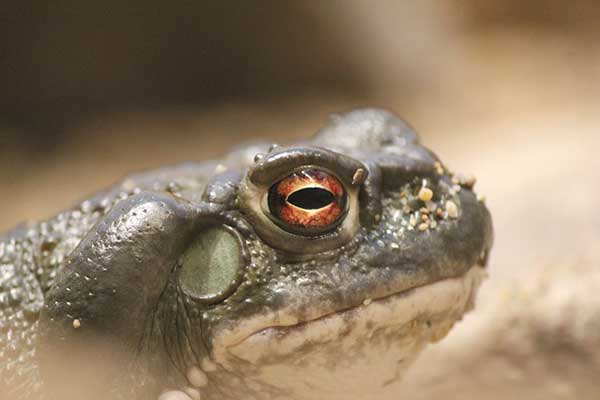
Scientific Name: Incilius alvarius
One of the most commonly known toads that live in the desert is the Sonoran Desert Toad. It‘s a species of amphibian found in the Sonoran Desert of southwestern New Mexico and central Arizona. This species has a greenish gray on top and white on the bottom, and a dry, warty skin that isn’t too slippery.
When handled or under stress, the toad secretes toxins from its skin, making it difficult for predators to consume it. Sonoran Desert Toads eat mostly insects and other invertebrates like worms and beetles, but they’ll also eat small vertebrates like mice and other frogs.
6. Couch’s spadefoot toads
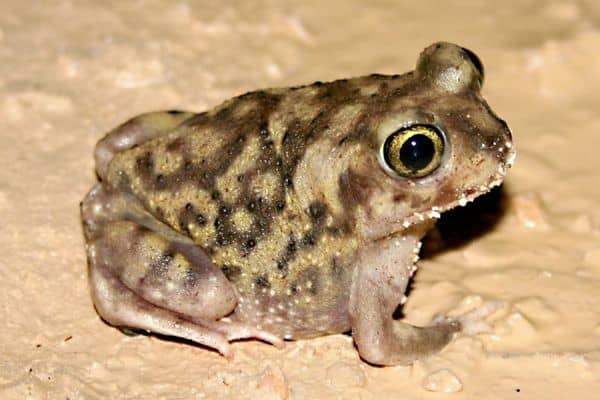
Scientific Name: Scaphiopus couchii
Couch’s spadefoot toad is a small spadefoot toad with a short, stocky body that can be green, yellow, or olive in color. This amphibian is found in North American deserts, particularly in Arizona, Texas, and Mexico. It lives in areas with loose sand or sandy soil, digging burrows up to 35 inches deep.
This spadefoot toad is also known to thrive in arid environments, but you can also find it in short grass prairies and grasslands. This species eats beetles, grasshoppers, katydids, ants, spiders, and termites in their natural habitats. It only gets to eat during the rainy season, so they usually consume a year’s worth of food.
7. Great Plains toad

Scientific Name: Anaxyrus cognatus
The Great Plains toad is an amphibian species found in the Sonoran desert. It’s found in Canada, Mexico, and the United States. This toad primarily feeds on cutworms, but it’ll also eat crickets, grasshoppers, spiders, moths, caterpillars, flies, beetles, and other bugs.
This amphibian is brownish-green in color with dark blotches on its back. It can grow to be 4 inches long, with females being larger than males. During the breeding season, Great Plains toads emerge from beneath the ground and breed on rain pools, flooded areas, and ponds.
8. Western narrow-mouth toad
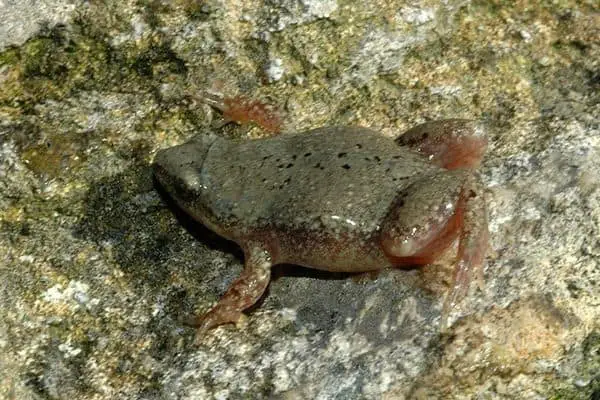
Scientific Name: Gastrophryne olivacea
The Western narrow-mouth toad is a North American endemic found in Texas, Oklahoma, Kansas, and Mexico. You can find it in a wide range of environments, including arid deserts, forests and woodlands, and grasslands. This small amphibian can grow to be only 1 inch long when fully grown.
It has a brownish to green and gray body with a white underside. The toads emerge from beneath the ground during the breeding season, which lasts from late May to early July. During this time, males produce a sticky substance on their belly that they use to stick to their mate.
9. Plains Spadefoot
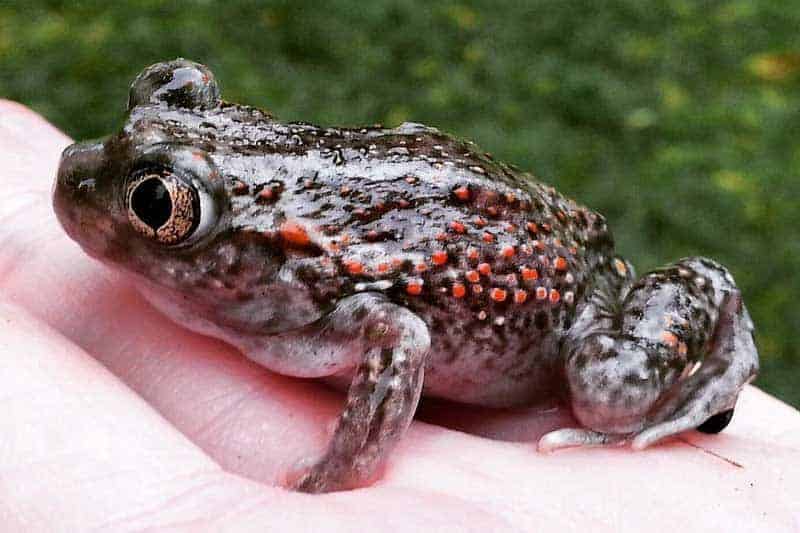
Scientific Name: Spea bombifrons
The Plains Spadefoot is brownish-gray in color with dark spots and large light-colored eyes. This Spadefoot can be found throughout North America, from Alberta to Mexico. It prefers sandy or rocky soil in dry or semi-arid habitats such as prairies and deserts.
This amphibian generally lives near water sources such as springs and streams but can also be found away from water in dunes or rock outcroppings, where it spends most of its time underground during periods of drought or extreme heat. Ants, centipedes, and beetles are just a few examples of the various species of ground-dwelling bugs that they’ll eat.
10. North American green toad
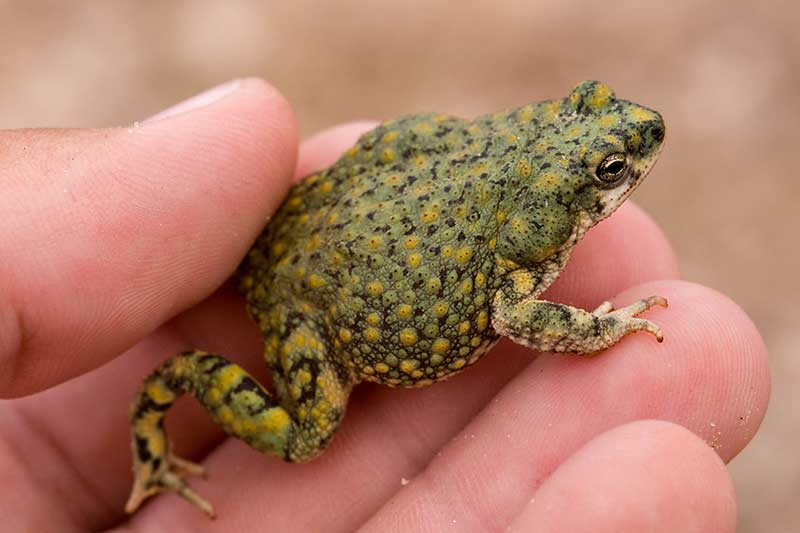
Scientific Name: Anaxyrus debilis
This green toad is a species that’s native to North America. They’re typically found in Arizona, Kansas, Oklahoma, Mexico, and other areas with dry sandy environments. These species breed from late March to August, emerging from the ground activated by rainfall.
The amphibians are only 1.8 inches long and have green and black spots. Males typically have yellow skin and are smaller than females. They feed on beetles, caterpillars, mites, and earwigs.




